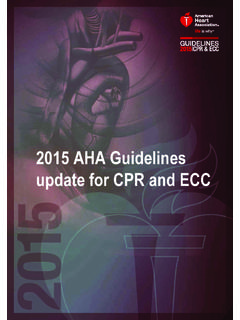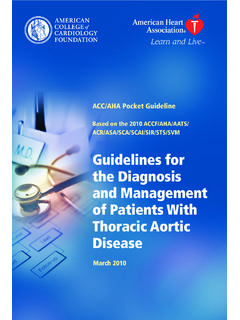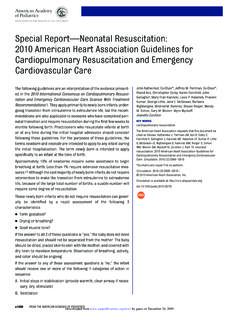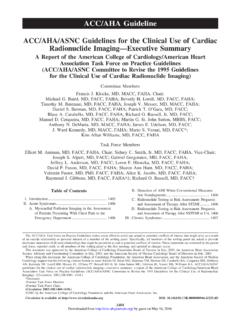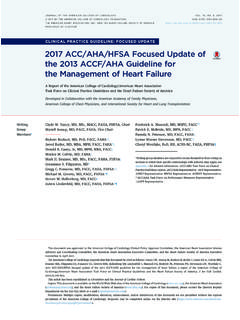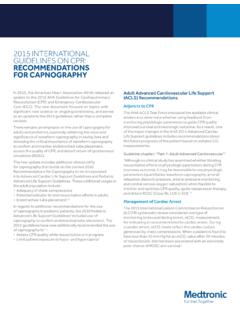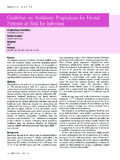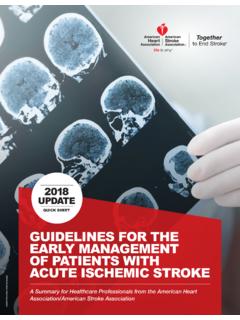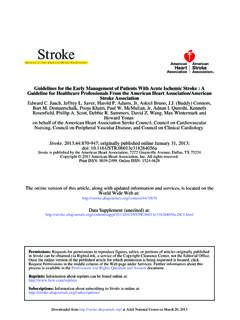Transcription of Comparison Chart 2015 AHA Guidelines for CPR and ECC
1 2015 american Heart association Guidelines Update EMBARGOED FOR RELEASE for CPR and Emergency Cardiovascular Care Oct. 15, 2015 , 12:01 , CST Comparison Chart of Key Changes 2015 Recommendation 2010 Recommendation Explanation Systems of Care and Continuous Quality Improvement Universal elements of a system of care have been identified to provide stakeholders with a common framework with which to assemble an integrated resuscitation system New for 2015 Healthcare delivery requires structure ( , people, equipment, education) and process ( , policies, protocols, procedures) that, when integrated, produce a system ( , programs, organizations, cultures) that leads to optimal outcomes ( , patient survival and safety, quality, satisfaction).
2 An effective system of care comprises all of these elements structure, process, system, and patient outcomes in a framework of continuous quality improvement. Separate Chains of Survival have been recommended that identify the different pathways of care for patients who experience cardiac arrest in the hospital as distinct from out-of-hospital settings. New for 2015 The care for all post cardiac arrest patients, regardless of where their arrests occur, converges in the hospital, generally in an intensive care unit where post cardiac arrest care is provided. The elements of structure and process that are required before that convergence are very different for the 2 settings.
3 Patients who have an OHCA depend on their community for support. Lay rescuers must recognize the arrest, call for help, and initiate CPR and provide defibrillation ( , public-access defibrillation (PAD)) until a team of professionally trained emergency medical service (EMS) providers assumes responsibility and then transports the patient to an emergency department and/or cardiac catheterization lab. The patient is ultimately transferred to a critical care unit for continued care. In contrast, patients who have an IHCA depend on a system of appropriate surveillance ( , rapid response or early warning system) to prevent cardiac arrest.
4 If cardiac arrest occurs, patients depend on the smooth interaction of the institution s various departments and services and on a multidisciplinary team of professional providers, including physicians, nurses, respiratory therapists, and others. 2015 american Heart association Guidelines Update EMBARGOED FOR RELEASE for CPR and Emergency Cardiovascular Care Oct. 15, 2015 , 12:01 , CST Comparison Chart of Key Changes It may be reasonable for communities to incorporate mobile technologies that summon rescuers who are in close proximity to a victim of suspected OHCA and are willing and able to perform CPR. New for 2015 There is limited evidence to support the use of mobile technologies by dispatchers to notify potential rescuers of a possible cardiac arrest nearby, and activation of mobile technologies has not been shown to improve survival from OHCA.
5 However, in a recent study in Sweden, there was a significant increase in the rate of bystander-initiated CPR when a mobile-phone dispatch system was used. Given the low harm and the potential benefit, as well as the ubiquitous presence of digital devices, municipalities could consider incorporating these technologies into their OHCA systems of care. Basic Life Support and CPR Quality In adult victims of cardiac arrest, it is reasonable for rescuers to perform chest compressions at a rate of 100 to 120/min. Also applies to BLS for Healthcare Providers. It is reasonable for lay rescuers and HCPs to perform chest compressions at a rate of at least 100/min.
6 New to the 2015 Guidelines Update are upper limits of recommended heart rate and compression depth, based on preliminary data suggesting that excessive compression rate and depth adversely affect outcomes. During manual CPR, rescuers should perform chest compressions to a depth of at least 2 inches (5 cm) for an average adult, while avoiding excessive chest compression depths (greater than inches [6 cm]). The adult sternum should be depressed at least 2 inches (5 cm). While a compression depth of at least 2 inches (5 cm) is recommended, the 2015 Guidelines Update incorporates new evidence about the potential for an upper threshold of compression depth (greater than inches [6 cm]), beyond which complications may occur.
7 Compression depth may be difficult to judge without use of feedback devices, and identification of upper limits of compression depth may be challenging. 2015 american Heart association Guidelines Update EMBARGOED FOR RELEASE for CPR and Emergency Cardiovascular Care Oct. 15, 2015 , 12:01 , CST Comparison Chart of Key Changes Untrained lay rescuers should provide compression-only (Hands-Only ) CPR, with or without dispatcher guidance, for adult victims of cardiac arrest. The rescuer should continue compression-only CPR until the arrival of an AED or rescuers with additional training. All lay rescuers should, at a minimum, provide chest compressions for victims of cardiac arrest.
8 In addition, if the trained lay rescuer is able to perform rescue breaths, he or she should add rescue breaths in a ratio of 30 compressions to 2 breaths. The rescuer should continue CPR until an AED arrives and is ready for use, EMS providers take over care of the victim, or the victim starts to move. If a bystander is not trained in CPR, the bystander should provide compression-only CPR for the adult victim who suddenly collapses, with an emphasis to push hard and fast on the center of the chest, or follow the directions of the EMS dispatcher. The rescuer should continue compression-only CPR until an AED arrives and is ready for use or EMS providers take over care of the victim.
9 All trained lay rescuers should, at a minimum, provide chest compressions for victims of cardiac arrest. In addition, if the trained lay rescuer is able to perform rescue breaths, compressions and breaths should be provided in a ratio of 30 compressions to 2 breaths. The rescuer should continue CPR until an AED arrives and is ready for use or EMS providers take over care of the victim. Compression-only CPR is easy for an untrained rescuer to perform and can be more effectively guided by dispatchers over the telephone. Moreover, survival rates from adult cardiac arrests of cardiac etiology are similar with either compression-only CPR or CPR with both compressions and rescue breaths when provided before EMS arrival.
10 However, for the trained lay rescuer who is able, the recommendation remains for the rescuer to perform both compressions and breaths. 2015 american Heart association Guidelines Update EMBARGOED FOR RELEASE for CPR and Emergency Cardiovascular Care Oct. 15, 2015 , 12:01 , CST Comparison Chart of Key Changes To help bystanders recognize cardiac arrest, dispatchers should inquire about a victim s absence of responsiveness and quality of breathing (normal versus not normal). If the victim is unresponsive with absent or abnormal breathing, the rescuer and the dispatcher should assume that the victim is in cardiac arrest. Dispatchers should be educated to identify unresponsiveness with abnormal and agonal gasps across a range of clinical presentations and descriptions.
